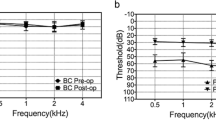Abstract
To evaluate hearing of the contralateral normal ear before and after mastoidectomy in a longitudinal manner and to assess whether the hearing loss is transient or permanent and to find out the duration of temporary hearing loss. This was a clinical longitudinal observational study involving 50 patients with unilateral chronic suppurative otitis media requiring mastoidectomy operation over a period of 18 months after satisfying the inclusion criteria. During the part of the mastoidectomy surgery involving drilling of the mastoid bone, noise levels were recorded at multiple points in the surgery using a digital sound level meter. Postoperatively, beginning from Day 1 to Day 7, PTA and OAE of the contralateral ear were recorded for all patients. The patients were then followed up at 1, 3 and 6 months postoperatively, at which times PTA and OAE were repeated. There is an increase in the absence of High Frequency DPOAEs on the first and second postoperative days, but this increase is higher than that of Low Frequency DPOAEs and gradually returns to normal by 72 h. OAEs were found to be more sensitive at diagnosing and tracking the progress of affected patients. All affected ears only had a temporary postoperative hearing loss, primarily affecting the higher frequencies and returning to normal within 72 h. Drill-generated noise and vibration during mastoidectomy operation is associated with a significant temporary shift in hearing thresholds of the contralateral normal ear in susceptible individuals, affecting the higher frequencies, and is best evaluated using DPOAEs.



Similar content being viewed by others
References
Karatas E, Miman MC, Ozturan O, Erdem T, Kalcioglu MT (2007) Contralateral normal ear after mastoid surgery: evaluation by otoacoustic emissions (mastoid drilling and hearing loss). ORL J Oto-Rhino-Laryngol Relat Spec 69(1):18–24
Doménech J, Carulla M, Traserra J (1989) Sensorineural high-frequency hearing loss after drill-generated acoustic trauma in tympanoplasty. Arch Otorhinolaryngol. 246(5):280–282
Kylén P, Arlinger SD, Bergholtz LM (1977) Peroperative temporary threshold shift in ear surgery. An electrocochleographic study. Acta Otolaryngol (Stockh) 84(5–6):393–401
Migirov L, Wolf M (2009) Influence of drilling on the distortion product otoacoustic emissions in the non-operated ear. ORL J Oto-Rhino-Laryngol Relat Spec. 71(3):153–156
Kylén P, Stjernvall JE, Arlinger S (1977) Variables affecting the drill-generated noise levels in ear surgery. Acta Otolaryngol (Stockh). 84(3–4):252–259
Da Cruz MJ, Fagan P, Atlas M, McNeill C (1997) Drill-induced hearing loss in the nonoperated ear. Otolaryngol Head Neck Surg 117:555–558
Tos M, Lau T, Plate S (1984) Sensorineural hearing loss following chronic ear surgery. Ann Otol Rhinol Laryngol 93:403–409
Turner CH, Forwood MR, Otter MW (1994) Mechanotransduction in bone: do bone cells act as sensors of fluid flow? FASEB J 8:875–878
Nomura S, Takano-Yamamoto T (2000) Molecular events caused by mechanical stress in bone. Matrix Biol 19:91–96
Kylen P, Stjernvall J-E, Arlinger S (1977) Variables affecting the drill-generated noise levels in ear surgery. Acta Otolaryngol 84:252–259
Tos M, Trojaborg N, Thomsen J (1989) The contralateral ear after translabyrinthine removal of acoustic neurinomas: is there a drill-noise generated hearing loss? J Laryngol Otol 103:845–849
Hallmo P, Mair IW (1996) Drilling in ear surgery: a comparison of pre- and postoperative bone-conduction thresholds in both the conventional and extended high-frequency ranges. Scand Audiol 25:33–38
Palva A, Sorri M (1979) Can an operation of deaf ear be dangerous for hearing? Acta Otolaryngol Suppl 360:155–157
Eddins AC, Zuskov M, Salvi RJ (1999) Changes in distortion product otoacoustic emissions during prolonged noise exposure. Hear Res 127:119–128
Man A, Winerman I (1985) Does drill noise during mastoid surgery affect the contralateral ear? Am J Otol 6:334–335
Goyal A, Singh PP, Vashishth A (2013) Effect of mastoid drilling on hearing of the contralteral ear. J Laryngol Otol 127(10):952–956
Author information
Authors and Affiliations
Corresponding author
Ethics declarations
Conflict of interest
None.
Rights and permissions
About this article
Cite this article
Latheef, M.N., Karthikeyan, P. & Coumare, V.N. Effect of Mastoid Drilling on Hearing of the Contralateral Normal Ear in Mastoidectomy. Indian J Otolaryngol Head Neck Surg 70, 205–210 (2018). https://doi.org/10.1007/s12070-017-1064-y
Received:
Accepted:
Published:
Issue Date:
DOI: https://doi.org/10.1007/s12070-017-1064-y



